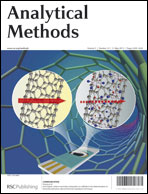An indirect competitive Enzyme-Linked Immunosorbent Assay (IC-ELISA) based on an anti-chelated copper monoclonal antibody DF4 was developed and analytically validated for Cu2+ detection in human hair and serum samples and its performance was compared with Atomic Absorption Spectrometry (AAS). The assay was validated by determination of the lower limit of detection, accuracy, linearity, precision, and reproducibility. The limits of detection were 0.029 μg mL−1 for human serum and 0.032 μg g−1 for human hair. The ratios for spiking recovery were from 80.2% to 108.6% for serum, and 95.3% to 106.79% from hair for two certified reference materials (CRM). The mean ratios of found to expected values for dilutional parallelism were 91.72 ± 3.39% for serum, and 97.28 ± 6.7% for hair. The coefficients of variation for intra- and inter-assay variability were <11.70% and <15.29% for serum, <14.02% and <16.40% for hair, respectively. The standardized IC-ELISA showed reliability and a high correlation with AAS of 0.983. We concluded that the ELISA described here was sufficiently sensitive, linear, accurate, precise, and reproducible for clinical evaluation. The availability of this assay may create a new research and diagnostic tool for copper measurement.

You have access to this article
 Please wait while we load your content...
Something went wrong. Try again?
Please wait while we load your content...
Something went wrong. Try again?


 Please wait while we load your content...
Please wait while we load your content...